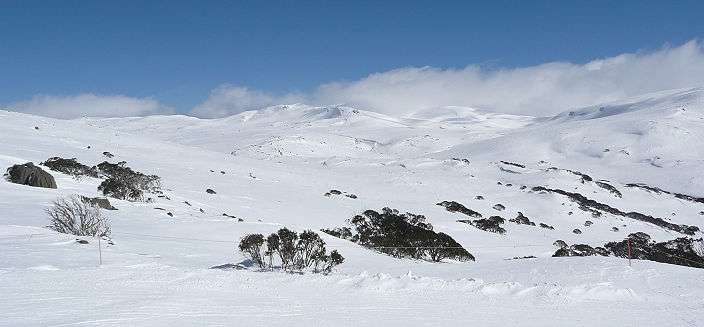Mount Kosciuszko
Mount Kosciuszko (/ˌkɒsiˈʌskoʊ/ KOZZ-ee-OZ-koh, previously spelled Mount Kosciusko) is mainland Australia's highest mountain, at 2,228 metres (7,310 ft) above sea level. It is located on the Main Range of the Snowy Mountains in Kosciuszko National Park, part of the Australian Alps National Parks and Reserves, in New South Wales, Australia, and is located west of Crackenback and close to Jindabyne.
| Mount Kosciuszko | |
|---|---|
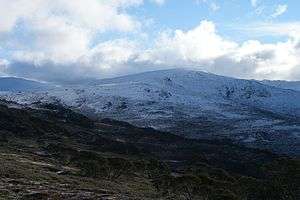 Mount Kosciuszko as seen from the Kosciuszko National Park | |
| Highest point | |
| Elevation | 2,228 m (7,310 ft) [1][2] |
| Prominence | 2,228 m (7,310 ft) [1] |
| Isolation | 1,894.26 km (1,177.04 mi) [1] |
| Listing |
|
| Coordinates | 36°27′21″S 148°15′49″E [3] |
| Geography | |
 Mount Kosciuszko 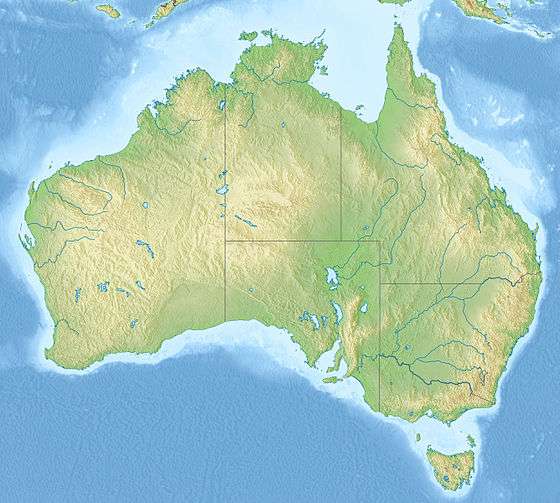 Mount Kosciuszko Mount Kosciuszko (Australia) | |
| Parent range | Main Range, Great Dividing Range |
| Topo map | Perisher Valley |
| Climbing | |
| First ascent | 1840 by Paweł Edmund Strzelecki (European)[1][3] Ancient Times by Indigenous Australians |
| Easiest route | Walk (dirt road) |
Etymology
The mountain was named by the Polish explorer Paweł Edmund Strzelecki in 1840, in honour of Polish-Lithuanian freedom fighter General Tadeusz Kościuszko,[note 1] because of its perceived resemblance to the Kościuszko Mound in Kraków, Poland.[4]
An exploration party led by Paul Edmund Strzelecki and James Macarthur beside him with indigenous guides Charlie Tarra and Jackey Tarra set off on what is called Strzelecki’s Southern expedition. Macarthur was seeking new pastures. Strzelecki wanted to investigate the climate, geology, paleontology and geography of NSW and to publish his findings.[5] This included identifying Australia’s highest summit, which Strzelecki reached on 12 March 1840.[6][7]
The approach was made from Geehi valley. After climbing Hannel’s Spur, the peak currently called Mt Townsend was reached. Here Strzelecki used his instruments to make observations. He noticed that the neighbouring peak was higher. In the presence of Macarthur he named the higher summit Mt Kosciusko after the famous Polish-Lithuanian military leader who died in 1817. As it was late, Macarthur decided to return to camp and Strzelecki alone climbed the Kosciuszko summit.
Based on Strzelecki’s records, Australia’s highest summit was mapped. A cartographical mistake made in an edition of Victorian maps transposed Mt Kosciusko to the position of the present Mt Townsend. Later editions of the map continued to show the original location. NSW maps did not make this mistake.
The Victorian error created confusion. In 1885, Austrian explorer Robert von Lendenfeld, guided by James M. Spencer,[8] a local pastoralist, aided by a map containing the transposition error, reached Mt Townsend believing it was Mt Kosciusko. According to Spencer, the local Aboriginals called Mount Kosciusko Tar-gan-gil. Like Strzelecki, Lendenfeld also observed that the neighbouring peak was higher. He named it Mt Townsend to honour the surveyor who in 1846 traversed the peak.
Lendenfeld claimed he identified and reached the highest peak of the continent. The NSW Department of Mines discovered Lendenfeld's mistake and assigned the name Mt Townsend to the second-highest mountain of the range. Lendenfeld's announcement created further confusion, and this is why people began to believe the incorrect story that the names of the two mountains were swapped.
The confusion was straightened out in 1940 by B. T. Dowd,[9] a cartographer and historian of the NSW Lands Department. His study reaffirmed that the mountain named by Strzelecki as Mt Kosciuszko was indeed, as the NSW maps had always shown, Australia’s highest summit. When Macarthur’s field book of the historical journey was published in 1941 by C. Daley,[10] it further confirmed Dowd’s clarification. This means that Targangil, mentioned in Spencer’s 1885 article,[8] was the indigenous name of Mt Townsend, not of Mt Kosciusko. According to A.E.J. Andrews, Mt Kosciuszko had no indigenous name.[11] Detailed analysis of the mountain history can be found in books by H.P.G. Clews[12] and in the cited A.E.J. Andrews' book Kosciusko: The Mountain in History.[6]
The name of the mountain was previously spelt "Mount Kosciusko", an Anglicisation, but the spelling "Mount Kosciuszko" was officially adopted in 1997 by the Geographical Names Board of New South Wales.[3] The traditional English pronunciation of Kosciuszko is /ˌkɒsiˈʌskoʊ/ KOSS-ee-US-koh, but the pronunciation /kɒˈʃʊʃkoʊ/ kosh-UUSH-koh is now sometimes used,[13] which is substantially closer to the Polish pronunciation [kɔɕˈtɕuʂkɔ] (![]()
Aboriginal names
There are several native Aboriginal (Ngarigo) names associated with Mt Townsend, where J. Macarthur recorded in 1840 some campings of the natives. There is some confusion as to the exact sounds. These are Jagungal, Jar-gan-gil, Tar-gan-gil, Tackingal; however, all of them mean Bogong Moth, which aestivate on the mountain. See the cited letter by A.E.J Andrews.[11]
In 2019, "Kunama Namadgi" was submitted to the Geographical Names Board of New South Wales as a proposed dual name for Mount Kosciuszko. The proposal was submitted by the Toomaroombah Kunama Namadgi Indigenous Corporation, which states that the proposed name means "snow" and "mountain". According to Uncle John Casey, the mountain's Ngarigo name has "been Kunama Namadgi for 4,000 years, since we've been on country, until the white man came in the early 1800s and that's when they changed it". However, Iris White, the chairperson of the Southern Kosciuszko Executive Advisory Committee, disputed that account, stating "that name is not from our language. It's offensive because in some of our languages 'Kunama' actually means faeces". White said that a new name should not be given "just for the sake of it sounding Aboriginal or sounding good".[14]
Formation
The mountain was formed by geologic uplift.[15] It was not formed by any recent volcanic activity.[16] Eroded granite intrusions remain at the summit as large boulders above the more heavily eroded sedimentary rocks.[16]
Reaching the summit
Mount Kosciuszko is the highest summit in mainland Australia. Until 1977 it was possible to drive from Charlotte Pass to within a few metres of the summit, but in 1977 the road was closed to public motor vehicle access due to environmental concerns. The road is open from Charlotte Pass for walkers and cyclists for 7.6 kilometres (5 mi)[17] to Rawson Pass, at an elevation of 2,100 metres (6,900 ft) above sea level. From there a 1.4-kilometre (1 mi) walking path leads to the summit. Cyclists must leave their bicycles at a bicycle rack at Rawson Pass and continue to the summit on foot. Anyone with a modest level of fitness can walk to the top.
The peak may also be approached from Thredbo, taking 3 to 3.5 hours for a round trip. This straightforward walk starts from the top of the Thredbo Kosciuszko Express chairlift, which operates all year-round. The walking path is popular in summer, and is a mesh walkway to protect the native vegetation and prevent erosion. It is 5 kilometres (3.1 mi) to Rawson Pass, where it meets the track from Charlotte Pass, and from where it is a further 1.4 kilometres (0.87 mi) to the summit. The walk to the summit is the easiest of all the Seven Summits.[18]
Australia's highest public toilet was built at Rawson pass in 2007,[19] to cope with the more than 100,000 people visiting the mountain each summer.[20]
The third and often overlooked route up Mount Kosciuszko is up the very challenging and historic Hannel's Spur Track (15.5 km), which approaches from the NW and is the only route to pass through the Western Fall Wilderness Zone – passing through four different bio-diversity bands along the ascent. The Hannel's Spur Track is officially Australia's biggest vertical ascent of 1800m. This is the same route that explorer Paul Strzelecki climbed and 'discovered' Kosciuszko in 1840 and also the same annual route that the stockmen once brought the cattle up/down from the valley almost 2 km below to graze in the alpine meadows of Kosi throughout the summer. The various aboriginal tribes from the Murray valley also used this same route annually for millennia to access Kosciuszko to harvest the delicacies of Bogong moths that were abundant throughout the summer months and to socialise with other tribes from the coast and northern plains. The Hannel's Spur Track trailhead (sign) is about a 1.4 km hike SSE of the Geehi Rest Area on the Alpine Way road between the towns of Thredbo and Khancoban.
The peak and the surrounding areas are snow-covered in winter and spring (usually beginning in June and continuing until October or later). The road from Charlotte Pass is marked by snow poles and provides a guide for cross-country skiers, and the track from Thredbo is easily followed until covered by snow in winter.
| ||||||||||||||

Recreation
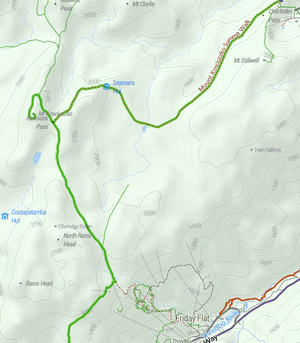
Kosciuszko National Park is also the location of the downhill ski slopes closest to Canberra and Sydney, containing the Thredbo, Charlotte Pass, and Perisher ski resorts. Mount Kosciuszko may have been ascended by Indigenous Australians long before the first recorded ascent by Europeans.
Each year in December, an ultramarathon running race called the Coast to Kosciuszko ascends to the top of Mount Kosciuszko after starting at the coast 240 kilometres (150 mi) away. Paul Every, who is credited as being the one who thought of holding such a race, was the inaugural co-winner in 2004.[21]
Higher Australian mountains
Higher peaks exist within territory administered or claimed by Australia: outside the continent are Mawson Peak (2,745 m or 9,006 ft) on Heard Island and Dome Argus (4,030 m or 13,220 ft), Mount McClintock (3,490 m or 11,450 ft) and Mount Menzies (3,355 m or 11,007 ft) in the Australian Antarctic Territory.
Although not in Australia, Puncak Jaya in New Guinea, Indonesia, which stands at 4,884 m or 16,024 ft, is the tallest mountain in the Australian continent and as well as Oceania.
In popular culture
Australian rock band Midnight Oil performed a song called "Kosciusko" on its 1984 album Red Sails in the Sunset, referring to the mountain. The spelling was updated to "Kosciuszko" for the group's 1997 compilation album, 20,000 Watt R.S.L.
The 1863 picture by Eugene von Guerard hanging in the National Gallery of Australia titled "Northeast view from the northern top of Mount Kosciusko" is actually from Mount Townsend.[22][23][24]
A species of lizard, Eulamprus kosciuskoi, is named for Mount Kosciuszko.[25]
Gallery
 Kosciuszko National Park as viewed from the summit
Kosciuszko National Park as viewed from the summit The base of a survey trig marker at the summit
The base of a survey trig marker at the summit- East side of the mountain
 Mount Kosciuszko Summit walk
Mount Kosciuszko Summit walk The summit from Charlotte Pass, New South Wales
The summit from Charlotte Pass, New South Wales- Mount Etheridge from south side showing high elevation toilet at Rawson Pass
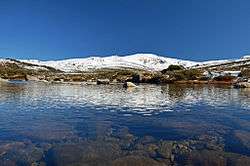 View of Mount Kosciuszko and the Etheridge Range from the headwaters of the Snowy River
View of Mount Kosciuszko and the Etheridge Range from the headwaters of the Snowy River- The plate at the top
 River flowing down from the summit
River flowing down from the summit- Lake Cootapatamba, the lake on the highest place in the Australian mainland
 Adjacent mountain ranges
Adjacent mountain ranges
Notes
- Kościuszko is also a national hero in Lithuania, and Belarus, and hero of the American Revolutionary War
References
- "Mountain Kosciuszko, Australia". Peakbagger.com. Retrieved 28 May 2015.
- "Kosciuszko National Park". Australian Alps National Parks. Australian Government. Retrieved 13 June 2009.
- "Mount Kosciuszko". Geographical Names Register (GNR) of NSW. Geographical Names Board of New South Wales. Retrieved 27 May 2015.

- "Australian Geographical Name Derivations". Wikiski.com. 8 April 2011. Retrieved 18 June 2012.
- Paul Edmund de Strzelecki Physical description of New South Wales and Van Diemen’s Land (1845). Adelaide : Libraries Board of South Australia, 1967 (Reprint)
- Alan E.J. Andrews, Kosciusko: The Mountain in History, O'Connor, A.C.T, Tabletop Press, 1991, p. 50.
- L. Paszkowski Sir Paul Edmund de Strzelecki : reflections on his life. Arcadia, Australian Scholarly Publishing. Melbourne [Vic.] 1997. ISBN 1875606394
- " Jas. M. Spencer The Highest Point in Australia The Sydney Morning Herald, February 18, 1885",
- Dowd, B.T. The Cartography of Mount Kosciusko. Royal Australian Historical Society. Journal & Proceedings, vol. 26, part I, pp. 97-107
- C. Daley Count Paul Strzelecki’s Ascent of Mt Kosciusko and Journey through Gippsland The Victorian Historical Magazine, vol.19, no 2, pp. 41-53, 1941
- Alan E. J. Andrews, FRAHS Mount Kosciusko, Our Highest Mountain, Letters to the Editor, Published in the Kosciuszko Hut Association Newsletter No: 108 Winter 2000
- H.P.G. Clews Strzelecki’s Ascent of Mount Kosciuszko 1840 Australia Felix Literary Club, Melbourne 1973
- Yallop, Colin, ed. (2005). Macquarie Dictionary (4th ed.). Melbourne: The Macquarie Library. ISBN 1-876429-14-3. Missing or empty
|title=(help) - "Mount Kosciuszko and the push to give our highest peak an Indigenous dual name". ABC News. 15 June 2019. Retrieved 15 June 2019.
- Geology Page: Geologists discover how Australia's highest mountain was created | Geology Page, accessdate: February 17, 2017
- Erfurt-Cooper, Patricia (2014). Volcanic Tourist Destinations. Springer Science & Business Media. p. 273. ISBN 9783642161919. Retrieved 24 April 2017.
- National Parks' 'Southern Kosciuszko walking tracks factsheet'
- Hamill, Mike (2014). Climbing the Seven Summits: A Comprehensive Guide to the Continents' Highest Peaks. The Mountaineers Books. p. 275. ISBN 9781594856495. Retrieved 24 April 2017.
- Lewis, Daniel (6 December 2006). "Celebrating the centenary of Australia's rooftop playground". Sydney Morning Herald. Retrieved 10 November 2018.
- "The rush to complete Australia's highest dunny" (PDF). Department of Environment and Climate Change, NSW. 3 May 2007. pp. 6–7. Archived from the original (PDF) on 9 November 2014.
- "Coast to Kosciuszko". Coast2kosci.com. Retrieved 18 June 2012.
- "Eugene von Guérard: North-east view from the northern top of Mount Kosciusko 1863". National Gallery of Australia. Archived from the original on 4 November 2008.
- Macdonald, John Boyd. "Home » Jokar projects » Ten-Mile Stare". Jokar Photography. Retrieved 8 July 2019.
Mt. Townsend, 19 November 1862. Eugene Von Guérard's painting
- "Strzelecki's Kosciusko by E. Axford". mtkosciuszko.org.au. Retrieved 23 October 2017.
- Beolens, Bo; Watkins, Michael; Grayson, Michael (2011). The Eponym Dictionary of Reptiles. Baltimore: Johns Hopkins University Press. xiii + 296 pp. ISBN 978-1-4214-0135-5. ("Kosciusko [sic]", p. 145).
External links
| Wikisource has the text of the 1911 Encyclopædia Britannica article Kosciusco. |
| Wikimedia Commons has media related to Mount Kosciuszko. |
- Mt Kosciuszko Inc. — page for information about explorer P. E. Strzelecki – and news about Mount Kosciuszko
- "Mount Kosciuszko". Peakware.com. Archived from the original on 4 March 2016. — photo
